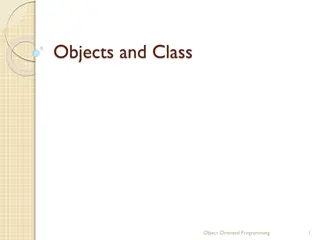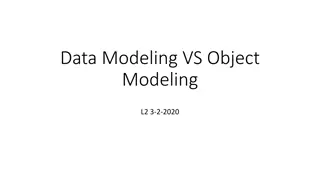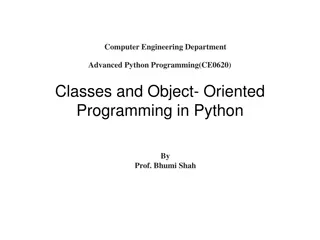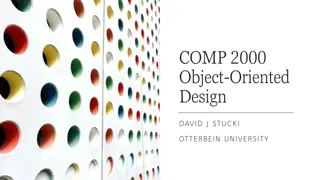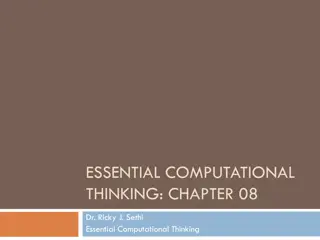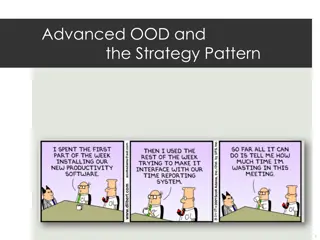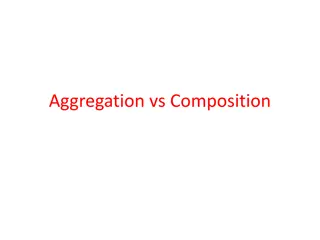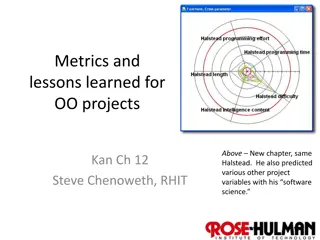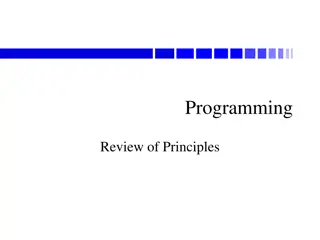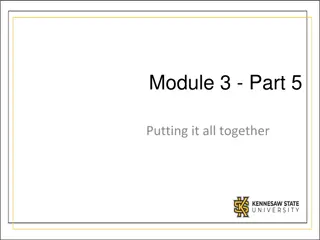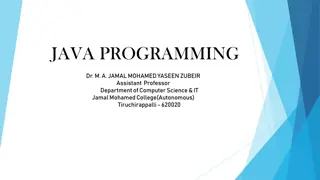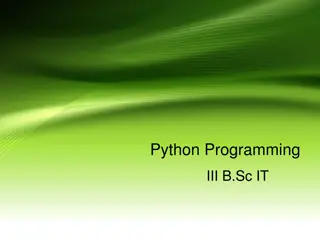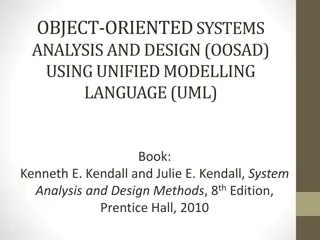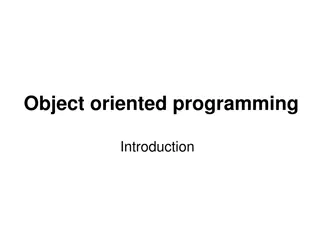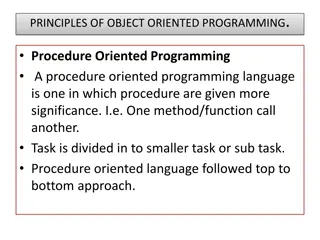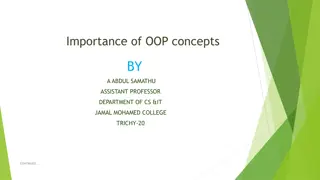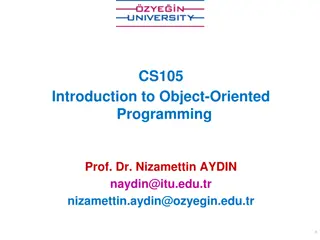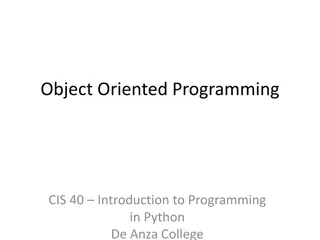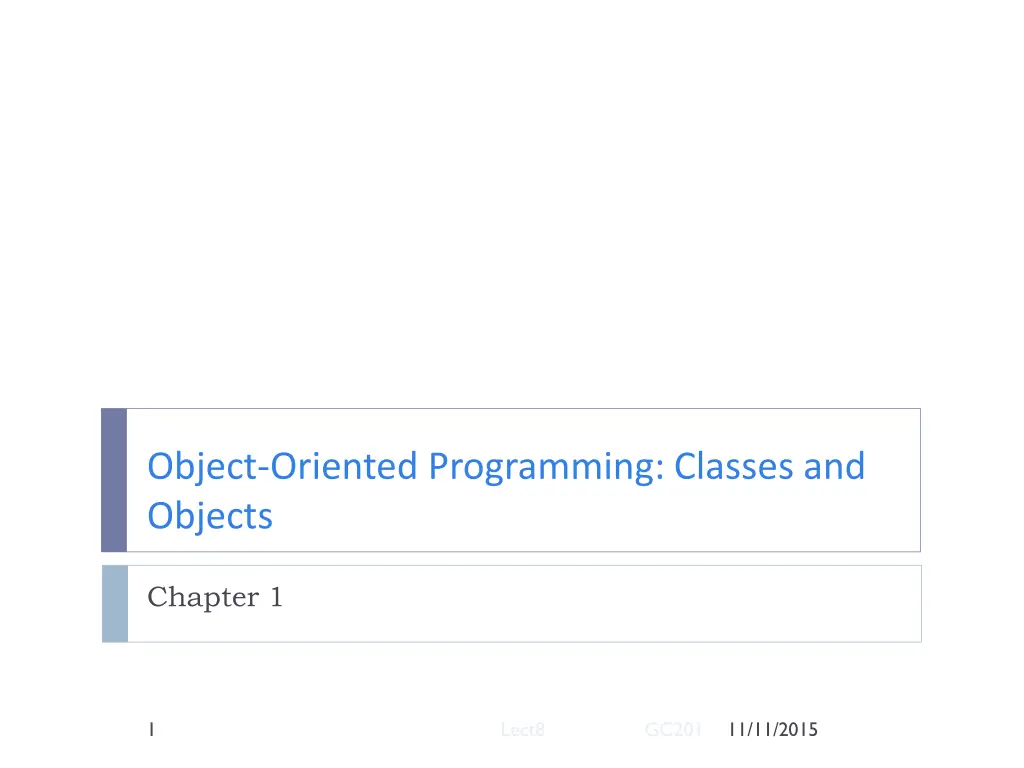
Understanding Object-Oriented Programming: Classes and Objects
Explore the fundamental concepts of classes and objects in object-oriented programming. Learn how classes represent abstract concepts and objects provide usable instances, with a focus on fields, properties, methods, and access levels. Understand class declarations and the significance of access modifiers. Dive into the world of OOP with real-world examples and practical applications.
Download Presentation

Please find below an Image/Link to download the presentation.
The content on the website is provided AS IS for your information and personal use only. It may not be sold, licensed, or shared on other websites without obtaining consent from the author. If you encounter any issues during the download, it is possible that the publisher has removed the file from their server.
You are allowed to download the files provided on this website for personal or commercial use, subject to the condition that they are used lawfully. All files are the property of their respective owners.
The content on the website is provided AS IS for your information and personal use only. It may not be sold, licensed, or shared on other websites without obtaining consent from the author.
E N D
Presentation Transcript
Object-Oriented Programming: Classes and Objects Chapter 1 1 Lect8 GC201 11/11/2015
2 Lect8 GC201 11/11/2015
Introduction Many applications consist of one or more classes, each containing one or more methods. If you become part of a development team in industry, you may work on applications that contain hundreds, or even thousands, of classes. In this chapter, we motivate the notion of classes with real-world examples and use complete working applications to demonstrate creating your own classes and manipulating objects of those classes. 3 Lect8 GC201 11/11/2015
Classes and Objects A class is an abstract representation of something. An object is a usable example of the thing the class represents. object is a structure containing data and methods that manipulate the data. 4 Lect8 GC201 11/11/2015
Fields, Properties and methods Classes are made of fields, properties and methods. Fields and properties represent information that an object contains. Fields are like variables in that they can be read or set directly. Example Car color. Properties are retrieved and set like fields, but are implemented using property Get and property Set procedures. Methods represent actions that an object can perform. For example, a "Car" object could have "StartEngine," "Drive," and "Stop" methods. 5 Lect8 GC201 11/11/2015
Class Declaration Public Class Car : : : End Class The keyword Public is an access modifier. Only Public classes can be reused in other projects. Every class declaration contains keyword Class followed immediately by the class s name. Every class s body ends with the keywords End Class. 6 Lect8 GC201 11/11/2015
Access Levels The access level of a declared element is the extent of the ability to access it, that is, what code has permission to read it or write to it. Public - elements are accessible from code anywhere within the same project, from other projects that reference the project. Protected - elements are accessible only from within the same class, or from a class derived from this class. Private - elements are accessible only from within the same module, class, or structure. 7 Lect8 GC201 11/11/2015
Class Member Variable (Field) Public Class Car Private color As String End Class Class members declared with member access modifier Private are accessible only within the class, which gives the class complete control over how those members are used. Class members declared with member-access modifier Public are accessible wherever the program has a reference to an Account object. Member variables declared with Dim default to Private access. 8 Lect8 GC201 11/11/2015
Class Property Use property procedure when: Need to control when and how a value is set or retrieved. Need to validate values. Setting the property causes changes to other internal variables or to the values of other properties. Visual Basic provides for the following property procedures: AGet procedure returns the value of a property. It is called when you access the property in an expression. ASet procedure sets a property to a value, including an object reference. It is called when you assign a value to the property. You usually define property procedures in pairs, using the Get and Set statements, but you can define either procedure alone if the property is read-only (Get Statement) or write-only (Set Statement). 9 Lect8 GC201 11/11/2015
Class Property 10 Lect8 GC201 11/11/2015
Class Constructor Public Class Car Private number As Integer Public Sub New( ByVal n As Integer) number = n End Sub End Class When you create an object of a class, the class s constructor is called to initialize the object. Constructors must be named New and are generally declared Public. Constructors are implemented as Sub procedures, because they cannot return values. 11 Lect8 GC201 11/11/2015
Class Constructor A constructor call is required for every object that s created. You can provide a parameterless constructor that contains code and takes no parameters, or that takes only Optional parameters so you can call it with no arguments. 12 Lect8 GC201 11/11/2015
Create Object Each object in Visual Basic is defined by a class. A class describes the variables, properties, procedures, and events of an object. Objects are instances of classes; you can create as many objects you need once you have defined a class. Dim VariableName As [New] ClassName You can also specify Public, Protected, Friend, Protected Friend, Private, Shared, or Static in the declaration. 13 Lect8 GC201 11/11/2015
Example classes Account and AccountTest. The Account class represents a bank account that has a balance, deposit and withdraw money transaction. The AccountTest class creates and uses an object of class Account. 14 Lect8 GC201 11/11/2015
Composition A class can have references to objects of other classes as members. This is called composition and is sometimes referred to as a has-a relationship. 15 Lect8 GC201 11/11/2015
Class Scope A class s instance variables and methods have class scope. Within this scope, a class s members are accessible to all of the class s other members and can be referenced simply by name. Outside a class s scope, class members cannot be referenced directly by name. Those class members that are visible (such as Public members) can be accessed through a variable that refers to an object of the class. 16 Lect8 GC201 11/11/2015
Object Initializers Object initializers use the With keyword to allow you to create an object and initialize its properties in the same statement. This is useful when a class does not provide an appropriate constructor to meet your needs. 17 Lect8 GC201 11/11/2015
Object Initializers To use object initializers, you follow the object creation expression with the With keyword and an object initializer list a comma-separated list in curly braces ({ }) of properties and their values as in the following statements: Dim timeObj1 As New Time() With {.Minute=33, .Second=12} Dim timeObj2 As New Time() With {.Minute = 45} The With keyword indicates that the new object is used to access the properties specified in the object-initializer list. Each property name must be preceded by the dot separator (.) and can appear only once in the object-initializer list. 18 Lect8 GC201 11/11/2015
Object Initializers The object-initializer list cannot be empty and cannot contain properties that are declared as Shared, Const or ReadOnly The object initializer then executes the property initializers in the order in which they appear. 19 Lect8 GC201 11/11/2015
Auto-Implemented Properties To write properties that do not have any additional logic in their Set and Get accessors, there is a new feature in Visual Basic 2010 called auto-implemented properties that allows you to write one line of code and have the compiler to generate the property s code for you. Example: if the Hour property did not require validation in, we could have replaced line 5 and lines 29 41 with Public Property Hour As Integer The compiler would then generate a Private instance variable of type Integer named _Hour and the following property code Public Property Hour As Integer Get Return _Hour End Get Set(ByVal value As Integer) _Hour = value End Set End Property 20 Lect8 GC201 11/11/2015
21 Lect8 GC201 11/11/2015
Using Me to Access the Current Object Every object of a class shares one copy of the class s method declarations. object s methods can manipulate the object s data. But how do methods know which object s instance variables to manipulate? Every object can access itself through its Me reference. On every call to a non-Shared method, the compiler passes an object s Me reference as an implicit argument. 22 Lect8 GC201 11/11/2015
Using Me to Access the Current Object Accessing Shadowed Instance Variables with Me When a method has a parameter or local variable with the same name as one of the class s instance variables, the instance variable is hidden until the method terminates execution this is called shadowing. You can use the Me reference to access the shadowed instance variable. Assume that we have a Time class with hour, minute and second instance variables. 23 Lect8 GC201 11/11/2015
Using Me to Access the Current Object The following Time class constructor s parameters shadow (have the same name as) the class s instance variables, so we use Me to access each shadowed instance variable: Public Sub New(ByVal hour As Integer, ByVal minute As Integer, ByVal second As Integer) Me.hour = hour ' initialize instance var hour Me.minute = minute ' initialize instance var minute Me.second = second ' initialize instance var second End Sub ' New 24 Lect8 GC201 11/11/2015
Shared Class Members Each object has its own copy of the instance variables of its class. In certain cases, all objects of a class should share only one copy of a particular variable. A Shared class variable represents classwide information all objects of the class share the same variable, no matter how many objects of the class have been instantiated. Together, a class s instance variables and Shared variables are know as the class s fields. 25 Lect8 GC201 11/11/2015
Example 26 Lect8 GC201 11/11/2015
Shared Class Members Scope of Shared Shared class members have class scope. A class s Public Shared members can be accessed via the class name using the dot separator. A class s Private Shared members can be accessed by clients only indirectly through the class s non-Private methods and properties. Shared Members 27 Lect8 GC201 11/11/2015
Shared Class Members Shared Shared Members and the Me Shared methods and properties do not have access to the Me reference, which can be used to directly access only non-Shared class members. Me Reference 28 Lect8 GC201 11/11/2015
Shared Class Members Shared Shared Constructors Shared variables are often initialized to their default values or to other values in their declarations. When a Shared variable requires initialization that cannot be accomplished in its declaration (such as complex calculations or constructor arguments), you can perform the initialization in a Shared constructor. Shared constructor preceded by the shared modifier and must be declared public, without parameter. 29 Lect8 GC201 11/11/2015
Shared Methods Example Class Math provides a collection of Shared methods that enable to perform common mathematical calculations. Math.Sqrt(900.0) 30 Lect8 GC201 11/11/2015
Const and ReadOnly Fields Constants are fields whose values cannot change during program execution. To create a constant in a class, declare an identifier as either Const or ReadOnly. Neither type of constant can be modified once initialized. 31 Lect8 GC201 11/11/2015
Const and ReadOnly Fields Const A Const identifier must be initialized at compile time in its declaration and can be initialized only to constant values. Example : Private Const NUMBER_OF_CARDS As Integer = 52 32 Lect8 GC201 11/11/2015
Const and ReadOnly Fields ReadOnly In some cases, a constant s value is not known until execution time: The constant is initialized with a non-constant value (such as a variable) The constant must be initialized with a (possibly) different value on a per-object basis. An identifier declared as ReadOnly can be initialized either in its declaration or in the class s constructor(s). 33 Lect8 GC201 11/11/2015
Const and ReadOnly Fields Example: The following declaration creates an employeeID constant that might be part of an Employee class: Private ReadOnly employeeID As Integer To initialize the constant employee-by-employee, you can use the constructor: Public Sub New(ByVal ID As Integer) employeeID = ID End Sub 34 Lect8 GC201 11/11/2015
Const and ReadOnly Fields Accessing Public Constants from Client Code Consts are implicitly Shared. If you have a Public Const value, client code can access it with the class name followed by the dot separator and the Const s name. Each object of a class with a ReadOnly constant has a separate copy of the constant, unless you explicitly declare the constant as Shared. If you have a Public ReadOnly constant in your class, client code can access it via a reference to an object of that class. 35 Lect8 GC201 11/11/2015

